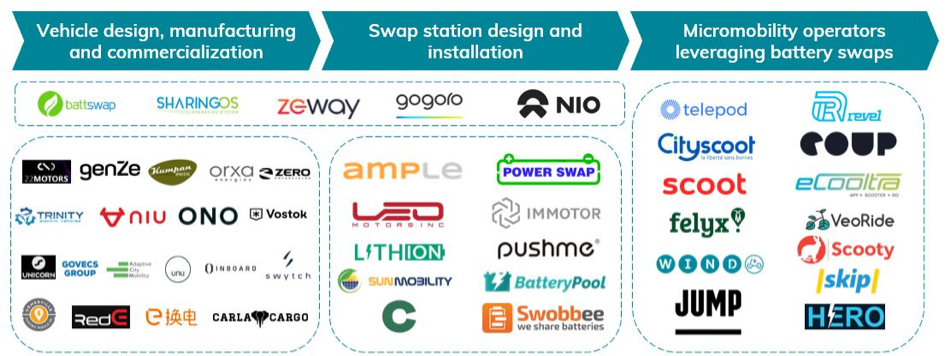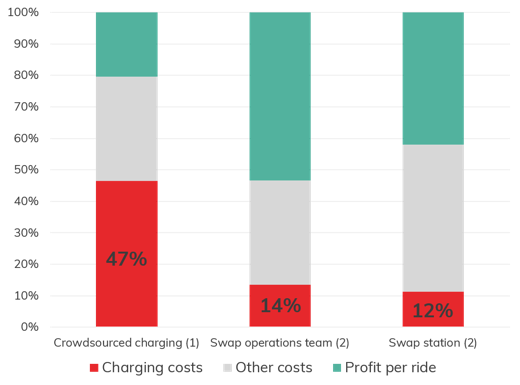At Aster, we’re really into electric mobility and we’re happy to see it’s picking up pace! E-micromobility is adding new layers of flexibility to urban transit, and more than half of all passenger vehicle sales are projected to be electric by 2040. That said, one key hurdle remains for EVs of all sizes: charging.
It goes without saying that the operating time for an electric vehicle is limited due to charging. For passenger cars, this means people are worried they won’t be able to use their vehicle when they need it. For micromobility operators, charging creates hefty operational expenses and a pool of untapped value for when their vehicles are recharging and off the street.
In comes battery swapping, enabling EV owners and operators to replace depleted batteries with fully charged ones in less than a couple of minutes. But which players are developing battery swap solutions? Where does swapping struggle and where can it add value? What could battery swapping look like in the future?
We’ve studied up on battery swapping over the past couple of months, and after digging into the value chain and exchanging with startups in the space, we’d now like to shed some light on these questions.
The battery swap startup landscape and value chain

We found that the battery swap value chain could be broken down into three main segments: (1) vehicle design and manufacturing, (2) battery swap station design and installation and (3) micromobility operators using battery swapping in their business. Most of the startups we came across operate in one segment of the battery swap value chain, except for a few players (such as Gogoro and NIO) that are integrated in both vehicle manufacturing and the swap station design and installation.
The companies we’ve come across offer battery swap solutions for two main use cases, including passenger cars and micromobility.
Companies have struggled in scaling passenger car battery swapping
Some players have attempted making passenger cars with swapping capabilities, the most infamous of which being Better Place. After raising roughly $800 million, the Israeli startup ended up bankrupt in 2013. Tesla also tested swap stations in 2013 for Model S owners, which it ultimately scrapped and deployed supercharger networks instead. Now NIO is taking a swing at passenger car battery swapping, but has had a tumultuous year with significant staffing cuts and struggling financials.
So why is it so challenging for companies to scale electric passenger cars with battery swap capabilities?
We believe there are 3 main reasons:
- High installation costs: Building a reliable battery swap network is CapEx intensive. For Better Place, each swap station was initially projected to cost $500k but ended up with a price tag of roughly $2 million. These costs are remarkably higher than direct-current fast charging (DCFC) stations, where installation costs vary from roughly $25k to $200k.
- Complex go to market strategies: OEMs must agree with battery swap startups to build vehicles that are specifically suited for the design of the swap station. Even more, as there is no battery standardization between different electric cars, the stations will likely have unsustainable inventories of multiple battery types as new cars are released.
- Little acceptance from end–users: It seems increasingly unlikely that electric car owners will use swap stations as plug-in charging networks are becoming faster and more ubiquitous. In the case of Tesla’s pilot program, only 4–5 out of the first 200 participants were interested in swapping batteries. The low interest level was likely a result of the fact that a Model S could be charged for free and at high speeds (80% capacity in about 40 minutes), while in the swapping pilot, Tesla owners had to pay and book appointments to get a full charge, making the overall swap experience less compelling compared to Superchargers.
However, battery swapping can add a lot of value for money-losing micromobility startups

Micromobility is expected to boom in the coming years, with estimates of the e-scooter market alone reaching $40-$50 billion by 2025. But startups in the space need to move quickly to improve their unit economics to capture this market, as achieving profitability has been a significant hurdle so far.
Charging is a large operational expense for e-scooter companies, especially for those using a “crowdsourced” model, where individuals are paid to locate, recharge and rebalance scooters. Bird is an example of a company that has suffered as a result of this model. At one point in 2018, 47% of their total cost of revenue went towards charging expenses as a result of the crowdsourced model.
Other e-scooter companies have opted for hiring operational teams instead to collect the e-scooters and take them to charging and maintenance facilities. However, this model still requires that the scooters are off the streets for several hours to recharge, reducing overall revenue potential.
This is where battery swapping can make a meaningful difference. It adds two layers of value for micromobility operators, as it can reduce charging costs while also maximizing vehicle uptime. Swapping can be used in two different models:
1. Operational battery swap teams: Companies can hire operational teams that are tasked with swapping batteries and taking depleted ones to a charging facility. This model has recently caught the attention of operators in the space and is currently used by Uber’s JUMP. Skip recently announced they plan on switching to this charging model as well.
2. Swap stations: Operators can also opt to deploy stations or kiosks in retail stores or city streets, where users are incentivized in the form of ride credits to swap the batteries on their own.
Operational swap teams and swap stations can reduce charging expenses as a percentage of revenue per ride

But why would battery swapping work better in micromobility than it has with passenger cars? For one, it’s much easier for micromobility operators to agree with light vehicle OEMs to create battery swap capable scooters and bikes compared to passenger car OEMs. Also, battery swapping in micromobility can enable an incentive system where end-users are encouraged to exchange batteries to earn ride-credits, a mechanism that did not exist for passenger car swap stations.
So what’s next for battery swapping?
Passenger car battery swapping remains complicated due to high installation costs, complicated go to market strategies and unclear user acceptance. However, as the e-scooter and broader micromobility markets grow and consolidate, operators will be on the lookout to boost margins using operational innovations. We expect battery swapping to play an important role in helping these companies remain competitive by beefing up their unit economics and maximizing vehicle uptime.
But which battery swapping model will be adopted by operators? What will the role of hardware manufacturers be as e-scooters and e-bikes move towards battery swapping? Will operators develop their own swapping technology, or rely on 3rd parties such as Pushme or SharingOS? Will customers be swapping batteries in the future?
JUMP recently hinted they are considering moving towards user-based battery swapping. Although this charging model makes sense from a unit economics perspective, several hurdles remain, including user acceptance, creating a sustainable incentivization strategy and finding locations to place swap stations.
